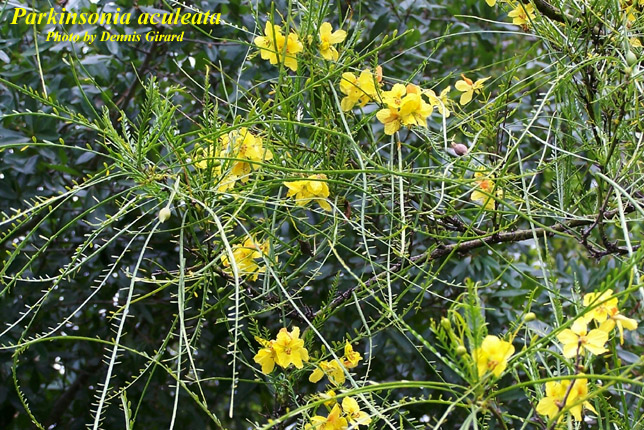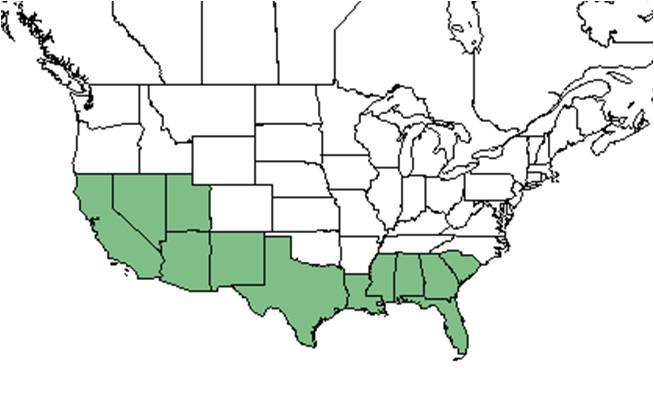Difference between revisions of "Parkinsonia aculeata"
KatieMccoy (talk | contribs) |
KatieMccoy (talk | contribs) |
||
| Line 29: | Line 29: | ||
===Habitat=== <!--Natural communities, human disturbed habitats, topography, hydrology, soils, light, fire regime requirements for removal of competition, etc.--> | ===Habitat=== <!--Natural communities, human disturbed habitats, topography, hydrology, soils, light, fire regime requirements for removal of competition, etc.--> | ||
Habitats include grasslands, open woodlands, rangelands, pastures, waste areas, disturbed sites, roadsides, and near creeks <ref name="keys">[[http://keys.lucidcentral.org/keys/v3/eafrinet/weeds/key/weeds/Media/Html/Parkinsonia_aculeata_(Parkinsonia).htm]] Accessed: February 16, 2016</ref>. It is adapted to life in the desert, by modified transpiration techniques and producing food with photosynthetic tissue in the bark <ref name="floridata">[[http://floridata.com/Plants/Fabaceae/Parkinsonia%20aculeata/217]] Floridata. Accessed: February 16, 2016</ref>. Soil types include sandy loam, sand, clay, and loam <ref name="hort">[[http://hort.ufl.edu/database/documents/pdf/tree_fact_sheets/paracua.pdf]] Accessed: February 16, 2016</ref> (FSU Herbarium). | Habitats include grasslands, open woodlands, rangelands, pastures, waste areas, disturbed sites, roadsides, and near creeks <ref name="keys">[[http://keys.lucidcentral.org/keys/v3/eafrinet/weeds/key/weeds/Media/Html/Parkinsonia_aculeata_(Parkinsonia).htm]] Accessed: February 16, 2016</ref>. It is adapted to life in the desert, by modified transpiration techniques and producing food with photosynthetic tissue in the bark <ref name="floridata">[[http://floridata.com/Plants/Fabaceae/Parkinsonia%20aculeata/217]] Floridata. Accessed: February 16, 2016</ref>. Soil types include sandy loam, sand, clay, and loam <ref name="hort">[[http://hort.ufl.edu/database/documents/pdf/tree_fact_sheets/paracua.pdf]] Accessed: February 16, 2016</ref> (FSU Herbarium). | ||
| + | |||
| + | If growing in an over-irrigated spot, ''P. aculeata'' is susceptible to powdery mildew and root rot<ref name="hort"/>. | ||
===Phenology=== <!--Timing off flowering, fruiting, seed dispersal, and environmental triggers. Cite PanFlora website if appropriate: http://www.gilnelson.com/PanFlora/ --> | ===Phenology=== <!--Timing off flowering, fruiting, seed dispersal, and environmental triggers. Cite PanFlora website if appropriate: http://www.gilnelson.com/PanFlora/ --> | ||
Revision as of 17:02, 15 February 2016
| Parkinsonia aculeata | |
|---|---|

| |
| Photo by Dennis Girard, Atlas of Florida Vascular Plants | |
| Scientific classification | |
| Kingdom: | Plantae |
| Division: | Magnoliophyta - Flowering plants |
| Class: | Magnoliopsida – Dicotyledons |
| Order: | Fabales |
| Family: | Fabaceae ⁄ Leguminosae |
| Genus: | Parkinsonia |
| Species: | P. aculeata |
| Binomial name | |
| Parkinsonia aculeata L. | |

| |
| Natural range of Parkinsonia aculeata from USDA NRCS Plants Database. | |
Common name: Jerusalem thorn, Mexican Palo Verde
Contents
Taxonomic notes
Description
Distribution
It is a native to Mexico but has spread and become naturalized in Florida[1].
Ecology
Habitat
Habitats include grasslands, open woodlands, rangelands, pastures, waste areas, disturbed sites, roadsides, and near creeks [2]. It is adapted to life in the desert, by modified transpiration techniques and producing food with photosynthetic tissue in the bark [3]. Soil types include sandy loam, sand, clay, and loam [4] (FSU Herbarium).
If growing in an over-irrigated spot, P. aculeata is susceptible to powdery mildew and root rot[4].
Phenology
Flowers and fruits March through August (FSU Herbarium).
Seed dispersal
Seed bank and germination
Fire ecology
Pollination
The following Hymenoptera families and species were observed visiting flowers of Parkinsonia aculeata at Archbold Biological Station (Deyrup 2015):
Apidae: Apis mellifera
Colletidae: Hylaeus confluens
Megachilidae: Anthidiellum notatum rufomaculatum, A. perplexum, Anthidium maculifrons, Coelioxys germana, C. sayi, C. texana, Dianthidium floridiense, Dolichostelis louisae, Heriades leavitti, Megachile brevis pseudobrevis, M. exilis parexilis, M. frugalis, M. georgica, M. inimica, M. integra, M. mendica, M. petulans, M. policaris, M. rugifrons, M. texana
Sphecidae: Ectemnius rufipes ais
Vespidae: Polistes exclamans
Use by animals
Diseases and parasites
Conservation and Management
Cultivation and restoration
Photo Gallery
References and notes
Deyrup, M.A. and N.D. 2015. Database of observations of Hymenoptera visitations to flowers of plants on Archbold Biological Station, Florida, USA.
Florida State University Robert K. Godfrey Herbarium database. URL: http://herbarium.bio.fsu.edu. Last accessed: October 2015. Collectors: Antonia Araiza, Robert Blaisdell, Kurt Blum, Ted Bradley, Richard Carter, Felipe Cisneros, J. Dwyer, Augustin Gamez, Robert K. Godfrey, James Henrickson, B.F. Meck, William R. Stimson, David W. Thompson, Edwin L. Tyson. States and Counties: Arizona: Maricopa. Florida: Dade, Leon, Pinellas. South Carolina: Beaufort. Texas: Live Oak, Victoria, Webb, Zapata. Countries: Costa Rica, Mexico. Compiled by Tall Timbers Research Station and Land Conservancy.